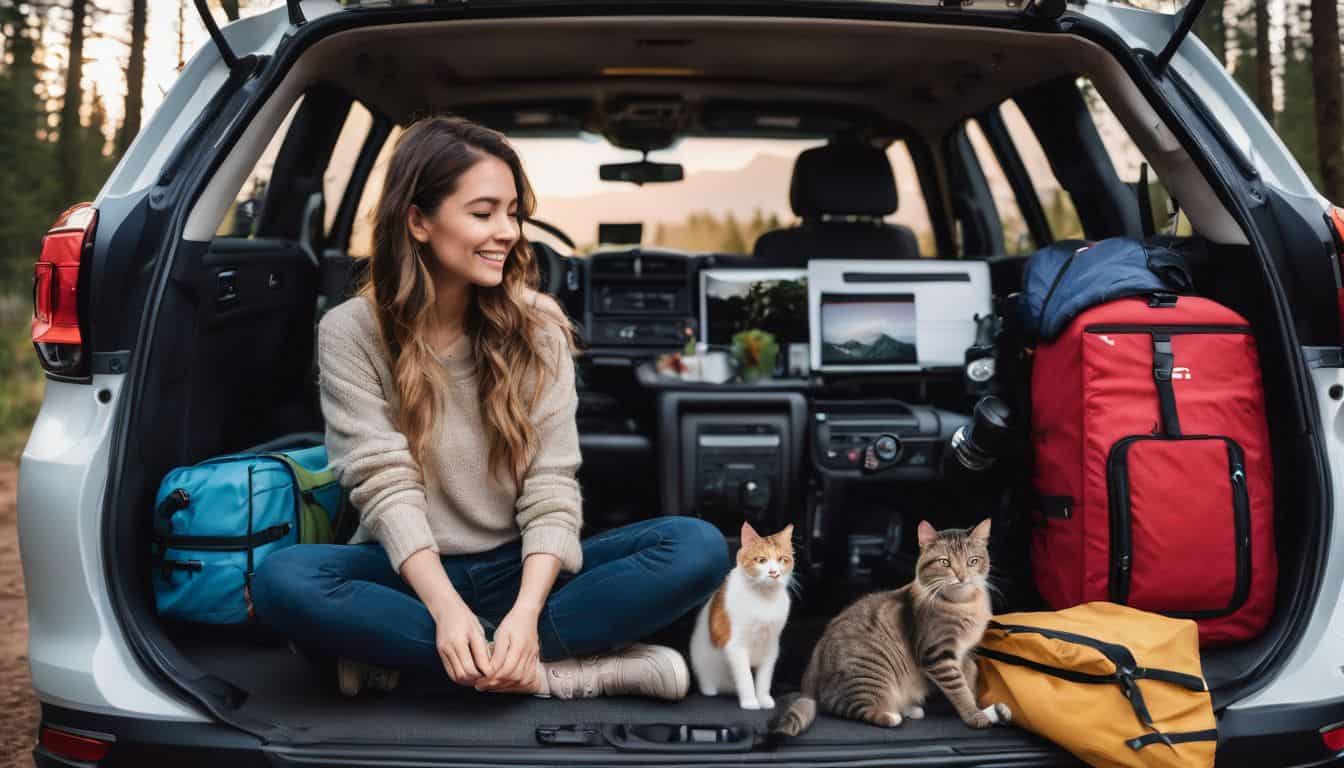Camping with your feline friend can be a rewarding experience, but it requires careful planning and preparation. This guide will help you navigate the challenges of traveling with your cat to a campsite and ensure a safe, enjoyable adventure for both of you. For a comprehensive overview, check out our guide on camping with cats.
Preparation Before the Trip
Assess Your Cat’s Personality
- Not all cats are suited for camping. Consider your cat’s temperament and adaptability to new environments.
- Start with short outdoor experiences to gauge your cat’s comfort level.
Understanding your cat’s personality is crucial before embarking on a camping trip. Some cats are naturally adventurous and adaptable, while others may become stressed in new environments. Observe how your cat reacts to changes at home and during short outdoor excursions. If your cat shows signs of extreme anxiety or fear, camping might not be the best activity for them.
Visit the Vet
- Ensure your cat is up-to-date on vaccinations and flea/tick treatments.
- Discuss any travel-related health concerns with your veterinarian.
A pre-trip vet visit is essential to ensure your cat is healthy enough for the adventure. Your vet can provide necessary vaccinations, flea and tick treatments, and advice on managing any existing health conditions during the trip. They may also recommend specific medications or supplements to help your cat cope with the stress of travel.
Choose a Pet-Friendly Campsite
- Research and select campsites that allow pets.
- Check for any specific pet policies or restrictions.
Not all campsites welcome pets, so thorough research is necessary. Look for sites that explicitly state they are pet-friendly. Check their specific policies regarding cats, as some may have rules about leashes, containment, or restricted areas. Consider factors like proximity to hiking trails or bodies of water that might pose risks to your cat.
Acclimate Your Cat to Camping Gear
- Introduce your cat to the tent, sleeping bag, and carrier at home.
- Practice short car rides if your cat isn’t used to traveling.
Familiarizing your cat with camping gear before the trip can significantly reduce stress. Set up your tent at home and encourage your cat to explore it. Let them sleep in their carrier or on the sleeping bag. If your cat isn’t used to car travel, take them on short drives to help them adjust to the motion and confinement.
Prepare Essential Gear
- Secure harness and leash
- Cat-specific backpack or carrier
- Collapsible litter box and litter
- Familiar bedding and toys
- Food and water bowls
- First-aid kit for pets
Having the right gear is crucial for a successful camping trip with your cat. A secure harness and leash are essential for safely exploring the outdoors. A cat-specific backpack or carrier provides a safe space for your cat during hikes or when you need to keep them contained. Don’t forget to bring their usual food, water, and litter to maintain consistency. A pet first-aid kit is crucial for handling minor injuries or health issues that may arise during the trip.
For a complete list of necessary items, visit our guide on cat camping gear.

Traveling to the Campsite
Secure Your Cat in the Vehicle
- Use a well-ventilated carrier or secure pet seat.
- Never let your cat roam freely in the car.
Proper containment during travel is crucial for your cat’s safety and your peace of mind. A well-ventilated carrier or a secure pet seat prevents your cat from distracting the driver or getting injured in case of sudden stops. The carrier should be large enough for your cat to stand, turn around, and lie down comfortably.
Plan for Breaks
- Stop every few hours for water, bathroom breaks, and stretching.
- Keep your cat on a leash during stops.
Regular breaks are important for your cat’s comfort and well-being during long trips. Plan to stop every 2-3 hours to offer water, allow for bathroom breaks, and give your cat a chance to stretch. Always keep your cat on a leash during these stops to prevent escapes. These breaks also give you a chance to check on your cat’s condition and comfort level.
Maintain a Comfortable Environment
- Ensure proper temperature control in the vehicle.
- Provide familiar items to reduce stress.
Creating a comfortable environment in the vehicle can significantly reduce your cat’s stress during travel. Maintain a comfortable temperature, avoiding extreme heat or cold. Bring familiar items like their favorite blanket or toy to provide comfort and a sense of security. Consider using pheromone sprays or diffusers designed to calm cats during travel.
At the Campsite
Set Up a Safe Space
- Create a secure area in the tent or RV for your cat.
- Set up the litter box in a private, easily accessible spot.
Upon arrival, prioritize setting up a safe, comfortable space for your cat. In a tent, this might be a corner with their bed and familiar items. In an RV, designate a specific area as your cat’s “home base.” Place the litter box in a quiet, accessible location. This safe space gives your cat a retreat when they feel overwhelmed by the new environment.
Supervise Outdoor Time
- Always keep your cat on a leash or in a secure enclosure when outside.
- Never leave your cat unattended at the campsite.
Outdoor time should always be supervised. Use a harness and leash designed for cats, or consider a portable cat enclosure for safer exploration. Constant supervision is crucial to prevent your cat from wandering off or encountering wildlife. Remember, even the most well-behaved cat can become disoriented or scared in an unfamiliar environment.
Maintain Routine
- Stick to your cat’s regular feeding and play schedule as much as possible.
- Provide familiar food and treats to maintain consistency.
Maintaining your cat’s routine can significantly reduce stress. Try to feed and play with your cat at the same times as you would at home. Bring their usual food and treats to avoid digestive issues. Familiar routines provide comfort and stability in the new environment.
Be Aware of Hazards
- Watch for wildlife, poisonous plants, and other potential dangers.
- Keep your cat away from campfires and cooking areas.
Campsite hazards can include wildlife, toxic plants, and human-made dangers like campfires. Research potential risks in your camping area beforehand. Keep your cat away from cooking areas to prevent burns or ingestion of harmful foods. Always be vigilant and ready to intervene if your cat encounters any potential danger.
Nighttime Safety
- Ensure your cat is secure inside the tent or RV at night.
- Consider using a light-up collar for better visibility in the dark.
At night, your cat should be safely contained in your tent or RV. A light-up collar can help you locate your cat quickly if they manage to slip out. Consider using a small night light in your sleeping area to help your cat navigate in the unfamiliar space.
For specific tips on camping with cats in a travel trailer, refer to our dedicated guide.
Additional Tips
- Identification: Ensure your cat wears a collar with ID tags and is microchipped.
- Weather Considerations: Check the forecast and pack accordingly.
- Respect Wildlife and Other Campers: Keep your cat from disturbing local fauna and be considerate of other campers.
- Leave No Trace: Clean up after your cat, including properly disposing of waste and litter.
These additional tips are crucial for responsible cat camping. Proper identification can be a lifesaver if your cat gets lost. Weather-appropriate gear ensures your cat’s comfort in various conditions. Respecting wildlife and other campers helps maintain a positive camping experience for everyone. Following Leave No Trace principles, including proper waste disposal, helps preserve the natural environment for future visitors.
To ensure your cat stays happy during the trip, learn how to keep your cat entertained while camping.
Remember, camping with a cat requires patience and flexibility. Be prepared to cut the trip short if your cat shows signs of extreme stress or discomfort. With proper preparation and a positive attitude, camping with your feline companion can be a unique and memorable experience.

Leave a Reply